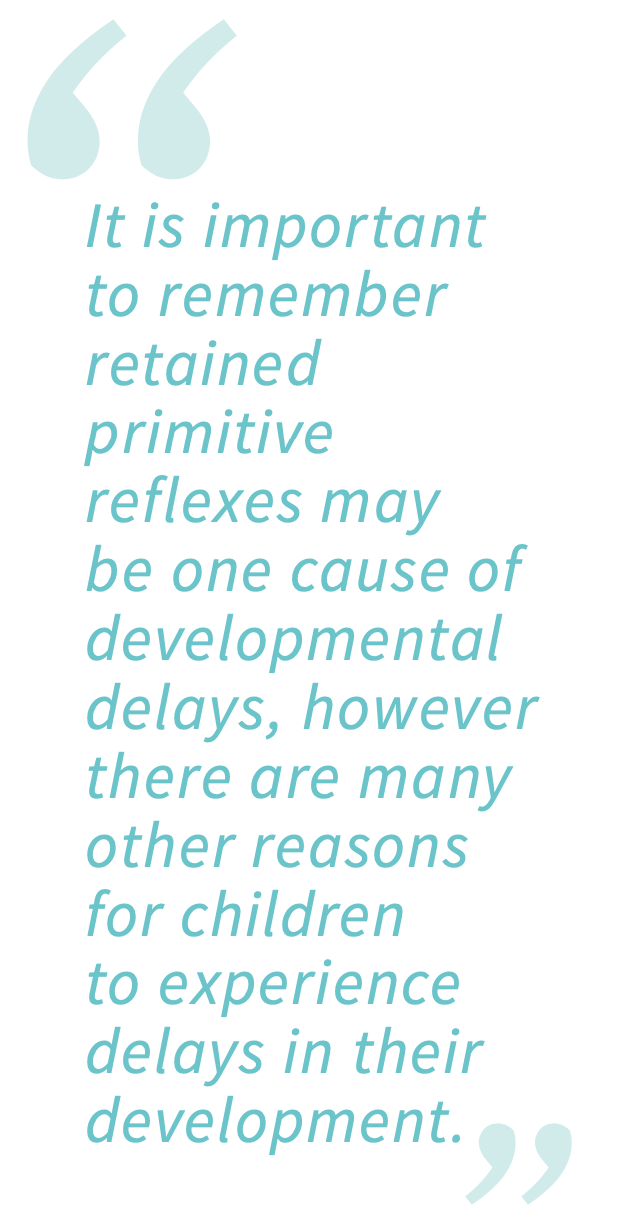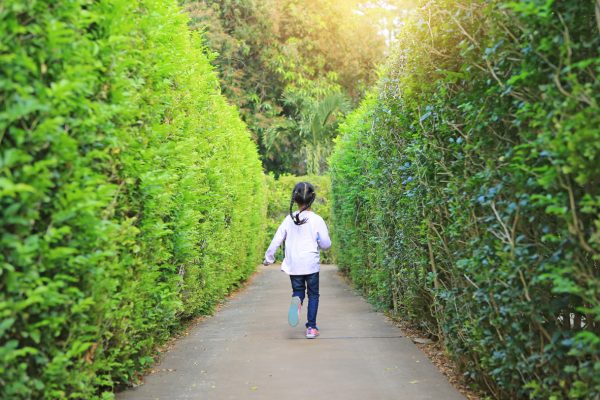
Primitive REFLEXES
What are they and how do they affect your child’s development?
They are there to protect your baby in their early days, but not all children’s primitive reflexes integrate when they should. The team at Occupational Therapy Helping Children explain what to look out for and when to seek help.
WHAT ARE PRIMITIVE REFLEXES?
Primitive reflexes are the first reflexes for our development. They are involuntary movement patterns that assist with survival in early childhood. These reflexes are usually naturally integrated in the first three years of life. However, they can be retained and may impact developmental delays.
There are many different primitive reflexes, but occupational therapists usually work with these five reflexes:
• Moro Reflex
• Asymmetrical Tonic Neck Reflex (ATNR) • Tonic Labyrinthine Reflex (TLR)
• Spinal Galant Reflex
• Symmetrical Tonic Neck Reflex (STNR).
Moro Reflex
The Moro Reflex is the baby’s automatic reaction to sudden sensory stimulation, such as bright light, change in temperature, touch, and others. Often called the startle reflex, you may have observed your baby throw back their head, extends out their arms and legs, cry, then pulls the arms and legs back in. This reflex will typically disappear between two and four months of age. Older kids with retained Moro Reflex might present with:
• Hypersensitivity to light, movement, sound, touch and smell.
• Motion sickness.
• Attention difficulties.
• Impulse control difficulties.
• Heightened responses to stimuli which might present in aggressive behaviours.
• Poor Balance — difficulties playing ball games.
Asymmetrical Tonic Neck Reflex (ATNR)
The ATNR is also known as the defensor position. It prepares the baby for future transitional movements like rolling, crossing the midline and hand-eye coordination. You may have observed it in your baby when they lie down on their back and turn their head to one side. Their arm and leg on the same side they are looking towards will extend, and the opposite side will bend. This reflex typically disappears between four and six months of age. Older kids with retained ATNR might present with:
• Lack of sense of direction.
• Hand dominance confusion.
• Handwriting difficulties.
• Reading difficulties.
• Focus and balance difficulties.

Tonic Labyrinthine Reflex (TLR)
The TLR assists the development of neck and head control and prepares the baby for rolling, crawling, standing and walking. You may see the TLR in your baby during tummy time. When the baby looks up, their arms and legs will extend. If the baby looks down, their arms and legs will bend towards their body. This reflex must be integrated between three and five years. Older kids with retained TLR might present with:
• Difficulties crawling.
• Poor posture control.
• Balance difficulties.
• Motion sickness.
• Toe walking.
• Lack of spatial awareness.
• Lack of interest in sports.
Spinal Galant Reflex
The primary function of the Spinal Galant Reflex is to support the baby during birth, helping the baby push their hips through the birth canal. Through early development this reflex can support the child to develop body awareness, postural control and co-ordination. You can observe this reflex in your baby by positioning them facing down, on your arms and tickling them with your index finger along one side of the spine. The reflex will present with the baby moving his hips towards the stimulated side. This reflex typically integrates between three and nine months after birth. Older kids with retained Spinal Galant reflex might present with:
• Difficulties with bladder control.
• Poor attention and concentration. • Difficulties sitting still.
• Back pain.
• Avoidance of wearing tight clothes.
Symmetrical Tonic Neck Reflex (STNR)
The STNR is also known as the crawling reflex. It supports the baby in building gross motor coordination skills, such
as separating arm and leg movements, developing balance, and controlling sitting posture. You may see this reflex in your baby when they move their head in a crawling position. If you gently bend their neck (move their head down), their upper body will bend, and their lower body will stretch. If you gently extend their neck (move their head up), their upper body will elongate, and their lower body will bend. This reflex typically integrates between nine and 11 months. Older kids with retained STNR might present with:
• No crawling.
• W sitting.
• Difficulties copying activities from the board at school.
• Toe walking.
• Difficulties with ball skills.
• Difficulties with eye-hand coordination.
WHAT ARE THE CAUSES OF RETAINED PRIMITIVE REFLEXES?
There are many factors that may contribute to primitive reflexes being retained including:
• Traumatic birth.
• C-section.
• Use of drugs and alcohol during pregnancy.
• Constant ear infections in early childhood.
• Insufficient tummy time.
• Delayed or difficulties crawling.
• Neurological conditions and divergences such as cerebral palsy, autism, ADHD or sensory processing issues.
• In some cases, primitive reflexes can reappear as a result of brain trauma, stroke, or brain lesions.
WHAT CAN I DO IF I HAVE CONCERNS?
It is important to remember retained primitive reflexes may be one cause of developmental delays, however there are many other reasons for children to experience delays in their development. If you are concerned about your child’s development, please talk to your child’s paediatrician, occupational therapist or physiotherapist.
Some great activities to assist with reflex integration are:
• Have your child complete activities when lying on the stomach. For example, watching TV, drawing, colouring, and playing board games.
• Crawling through tunnels.
• Obstacle courses.
• Wheelbarrow walks.
• Cat/cow yoga pose.
• Superman pose lying down on their stomach.
• Star jumps.
• Throwing a ball on a target.
• Roll down a ramp or a mountain of cushions.
Occupational Therapy Helping Children is a specialist team of occupational therapists in Sydney’s Frenchs Forrest dedicated to helping children thrive, offering one on one supports, as well as parent workshops and teacher training sessions. occupationaltherapy.com.au







